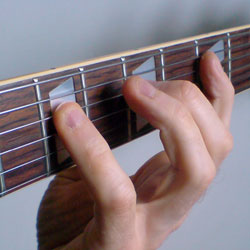
Using 3 note per string scales rather than standard scale shapes can help improve your speed and fluency. By learning scales with 3 notes per string you can also improve your fretboard knowledge and bring new sounds to your lead playing.
3 Note Per String Scales Introduction
Most lead guitarists learn scales in single position patterns that have either two or three notes per string. You can see the standard major scale shapes here: Major Scale Guitar. Learning major (and other) scales this way ties in nicely with the CAGED system, which means that each scale shape corresponds to a major chord shape. Pentatonic scales are also often grouped in single position shapes. However, learning and playing scales this way does have certain drawbacks: it can lead to a tendency to stick to one position while soloing, or to the other extreme of jumping around the neck to reach new positions. It is also more demanding on the right (picking) hand, because the notes are grouped unequally. For these reasons, it can be a worthwhile exercise to learn scales in patterns with 3 notes per string. Playing scales this way can open up the fingerboard and breathe new life into old scales.
3 Note Per String Scales Shapes
All of the scale shapes on this page are movable, meaning that they can be used to play the scale with any root note. Root notes are shown as white circles.
Major 3 Notes Per String Shapes
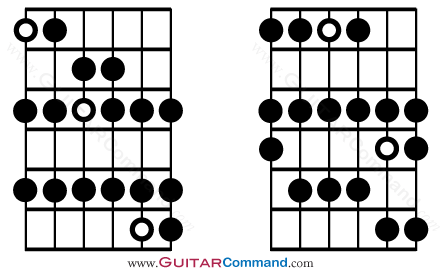
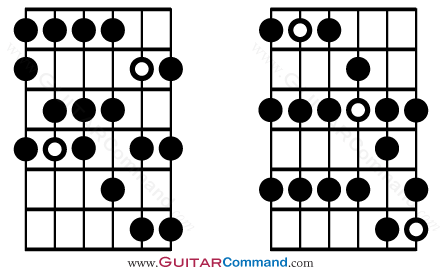
Standard Major Scale Shape
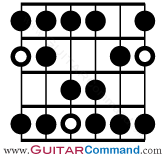
Compare playing the first of the 3 note per string scale shapes with the standard major scale pattern above. Play both types with alternate picking (i.e. alternating up / down strokes with the pick). Many guitarists find that the 3 note per string scale sounds smoother and is easier to play. The picking hand is able to find a more natural movement because it doesn't have to change between the two and three-note groups.
[ad name="Google Adsense Lge Rec"]
3 note per string scale shapes also cover a larger range of notes. If the shapes above are used to play a G major scale, the first 3 note per string shape ends at the C. The standard shape only reaches the A - with the same number of string changes.
Other Benefits
Grouping the notes of a scale differently can help you to find new licks and riffs. Your hands will be unable to fall into their usual physical patterns and new combinations of notes will hopefully begin to appear.
Legato Playing
Many guitarists use hammer-ons and pull-offs to increase scale speed. 3 note per string scales come into their own when this technique is used. Just one pick per string and two hammer-ons (ascending) or pull-offs (descending) can be used to play scales very quickly.
Modal Scales
Major scale shapes can also be used to play modal scales. Which modal scale is being played depends upon the start and end notes of the scale. For more information on modal scales, see guitar modes. Two examples are given below:
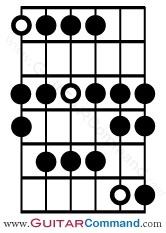
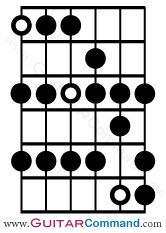
[ad name="Google Adsense Lge Rec"]
3 Note Per String Minor Scales
Continue exploring 3 notes per string scales by playing the harmonic minor shape below, then by creating your own in other positions. If you are using these shapes for the first time, you should already be coming up with some new sounds.
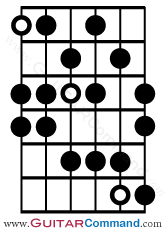
3 Notes Per String Pentatonic Scales
Standard pentatonic scale shapes usually have two notes per string. Unlike major and other eight note scales, pentatonic scales are actually harder to play in 3 note per string combinations. This is because playing them this way involves stretches beyond the comfortable 4-5 fret range and frequent position changes. However, 3 note per string pentatonic shapes are worth investigating because they can be used to create some very impressive sounding licks.

3 Note Per String Scales Conclusion
Playing 3 note per string scales can lead to new combinations of notes and can help you to find new sounds in your solos. 3 notes per string scales can also be easier to play than standard scale shapes.
The major, harmonic minor and pentatonic 3 note per string shapes will be a useful addition to your lead guitar armory. 3 note per string scales can be combined with standard scale shapes to increase the range of your solos. Try creating your own three note per string shapes with other interesting guitar scales.

